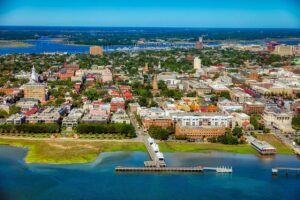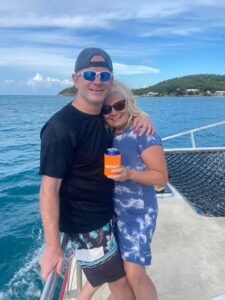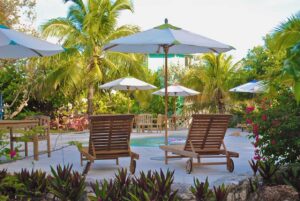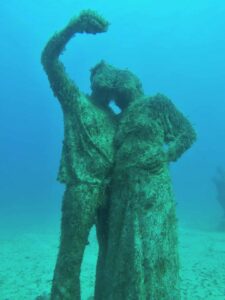CRUISING TO THE Dry Tortugas National Park by boat can be the most challenging part of this amazing destination. Locals warn about two seasons: Winter Storm (December-March) that features high winds and rough seas, and Tropical Storm (June-November), that features more of the same. April and May are known to be delightful.
We’d talked about and hoped to visit the Dry Tortugas for the last couple of years, as we spent time cruising Florida and the Florida Keys. With its wide-open waters and nowhere to seek safe harbor nearby, that cluster of islands in the Gulf of Mexico always ended up feeling a little out of reach. But as our experience with the boat and comfort with the shallow Florida waters grew, we decided it was time to head there.
Starting Point:
Ft. Pierce, FL
We left Ft. Pierce City Marina on M/V TAPESTRY, our Kadey Krogen 58, in early January to head to the Dry Tortugas before our arrival at Stock Island Marina Village in Key West on February 1. The weather and ocean were unsettled enough that we spent the day on the ICW rather than suffer the wave action outside. Once it all settled down, we were expecting to head outside the next day from Lake Worth.
Lake Worth to Ft. Lauderdale, FL
Estimated Mileage: 45.6 NM
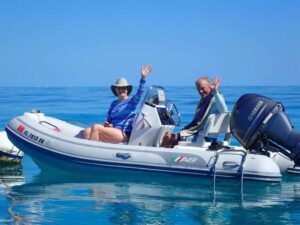
The winds and waves did not abate as predicted. Instead the foul weather intensified, and we needed to find somewhere to ride this storm out safely. Most everywhere was booked, but we finally secured a slip at Bahia Mar Resort and Yachting Center in Ft. Lauderdale. Surely this would soon blow by, and our adventure to the Dry Tortugas would continue. After several days, which turned into 10 days, we had to admit defeat. The Dry Tortugas would have to wait; we were out of time. Suddenly, the weather improved, and we headed to Key West. Maybe there is something to this Winter Storm season.
Key West to the Dry Tortugas, FL
Estimated Mileage: 67.8 NM
During the last week of our stay at Stock Island in Key West (so named because that’s where the Navy and Key West kept their livestock), a window opened up to cruise to the Dry Tortugas before arriving at our final destination in Marathon Marina on April 2. Our friends aboard Day Dreams, Lauryl Anne, Waterford and Sea Dweller agreed and joined us.
The passage itself was an easy 70-mile cruise by trawler. The north passage to Garden Key is shoaled in, but the south channel is straightforward, taking you past Fort Jefferson and then circling around the fort heading south, then east. The inner harbor is snug and secure, but on our arrival, it was full.
The outer harbor seems wide open but is somewhat protected by the continuation of the barely visible reef. This reef lies at the end of the Florida Reef System, the third largest reef in the world. We rocked and rolled the first night, but it didn’t stop our friends from joining us for a Low-Country boil and sunset conch blowing.
Garden Key, home of Fort Jefferson, was our first stop the next morning. While boarding our dinghy for the short trip over, we were startled by a huge goliath grouper hanging out in the shade under TAPESTRY! We beached our dinghies and headed to the fort after registering with the National Park ranger and purchasing Dry Tortugas wear in the gift shop. The fort’s history brought full circle what we learned about maritime history the year before in New Orleans, and along the way cruising the Florida coasts over the last four years.
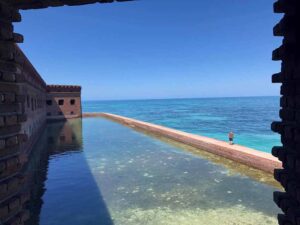
The remoteness of Dry Tortugas National Park is pretty extreme. There is no cell service or internet, no water, and no provisions to be had. You can watch the daily arrival and departure of the ferry from Key West as well as tourists coming and going by seaplane. We felt that the seaplanes took great pleasure in buzzing the anchored boats and landing close by. The ferry also brings a National Park ranger who conducts tours of the fort. We were entertained and educated by a wonderful guy named Hollywood! He’s a good storyteller. It’s definitely worthwhile to tag along on the tour.
In the afternoon, we decided to explore one of the other keys that comprise the Dry Tortugas — Loggerhead Key, named for the loggerhead sea turtles that make their home there. Loggerhead Key is a three-mile dinghy ride through “gin clear” water. On our way we stopped to dive a wreck off its southwestern side. The park provides mooring balls at dive sites to protect the healthy coral reef. Juvenile barracuda hovered around under the mooring but didn’t seem interested in our gang.
We landed our dinghies on Loggerhead Key and were welcomed by a couple who are volunteering there for a month. Now that’s something I’d like to do! The island houses the Marine Research Center, and volunteers keep up their housing as well as tend to the island’s maintenance needs. We walked across to the northwest side of the island and spread out on the beautiful beach overlooking Little Africa, which is a shallow reef just offshore that’s teeming with coral, tarpon, barracuda and lots of magnificent tropical fish.
After a fun potluck aboard Sea Dweller, we went to bed, sad that we’d be leaving in the morning. This was Tortugas 101 for us! We’ll be back for more: lots of beaches to walk, other areas and wrecks to dive, and birds to watch.
Thousands of migratory birds stop at the Tortugas in the spring and fall. They begin arriving in late February, and by March you see herons, ibises, hawks and shorebirds. From late-March to mid-May, the songbirds come by, up to 70 species per day for a total of about 300 species.
Dry Tortugas to Boca Grande Key, Marquesas, FL
Estimated Mileage: 50.3 NM
On our way to Marathon, we dropped the hook off Boca Grande Key in the Marquesas. Only one palm tree decorated the island’s silhouette. That was enough. The island, the ocean and the sunset were all we needed — that and time to reflect on our adventure.
Marquesas to Marathon, FL
Estimated Mileage: 58.1 NM
We arrived at Marathon Marina and relished the comforts of shore power and unlimited water. We had finally made it to the Dry Tortugas! The introduction left us wanting to come back and experience more. It was exhilarating to have made the trip to the most remote U.S. national park.
Step Back in Time at Fort Jefferson



